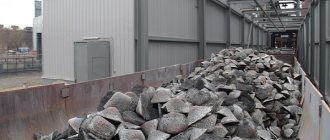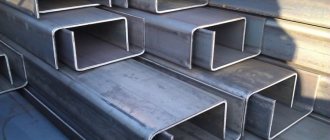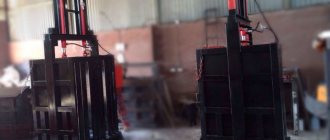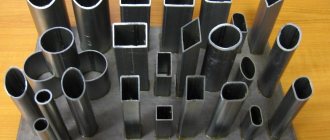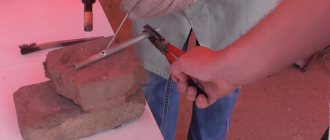Plastic containers are used as containers for many drinks. European countries have been processing such waste on an industrial scale for a long time, but in the Russian Federation this area is only just being developed. However, good plastic paving slabs can be made from waste. Moreover, the raw materials for such production are inexpensive and extremely accessible.
Advantages and disadvantages
The main advantage of paving stones made from plastic bottles is its affordable cost, due to low prices for raw materials for its production. The entire technology for manufacturing such products involves the use of additives, coloring pigments and plastic containers.
Advantages of polymer paving stones:
- does not become cracked when exposed to negative temperatures;
- polymer products are comparable in strength to concrete;
- It is easy to clear snow from plastic paths;
- frost does not form on the polymer coating;
- excellent adhesion to shoe soles, which minimizes the risk of injury due to a fall;
- the surface of the polymer tile is highly resistant to abrasion;
- plastic is characterized by a high level of moisture resistance;
- plastic is lightweight, so it is easy to install;
- the material is not afraid of exposure to chemicals;
- tiles made of polymers can withstand negative temperatures for a long time;
- PVC tiles can have different textures and colors.
This type of paving stone has only one drawback - when exposed to high temperatures, its dimensions increase. To prevent damage to the material under the influence of ultraviolet radiation, during the installation process it is necessary to maintain a 3-5 mm interval between the tiles.
Equipment
You will have to pay a large sum for the equipment of the enterprise, since it is quite expensive. A full-fledged high-performance production line will cost 1–1.5 million rubles. Domestic equipment for the production of tiles is cheaper. You will spend 950 thousand rubles to purchase it. This line consists of:
- Polymer crushers;
- Thermal screw mixing machine;
- Molding unit.
It provides a capacity of 35 sq. meters of high-quality tiles in one shift. Typically, a machine for the production of paving slabs is operated by no more than 5 people. Do not forget that personnel must control the quality of products at every stage so that defective products do not go on sale.
Forms
Manufacturers who produce molds for the production of paving slabs offer products made from different materials:
- Rubber. This technology is considered obsolete because such forms are too expensive and heavy. They will last only a few months and become unusable, so the costs of purchasing such products are unjustified.
- Fiberglass molds are usually used to produce bulk products or large tiles. They are used extremely rarely, since they require lubrication before each use and have irregular geometry.
- Plastic forms are the most common option. They are used in mass production of products in large volumes.
To make paving slabs from plastic waste, you can use the same molds as for concrete slabs.
Components of the material
For the production of PVC paving stones, not only plastic bottles, but also other polymers can be used. In addition, you will need dye and sand. Ordinary containers are suitable as raw materials, which do not even need to be cleaned of food residues and stickers. Excess components burn themselves during processing. In this case, the raw materials do not need to be sorted.
Plastic tile makers can also use parts from plastic canisters, boxes, film and bags. Moreover, it is recommended to use polyethylene parts in order to add shine to the finished product.
Soft types of polymers can increase the plasticity of finished tile products. If they are not added during production, the product becomes more fragile. Manufacturers adhere to the following proportions:
- solid polymer compounds – 60%;
- soft plastic – 40%.
Taking these proportions into account allows you to achieve the optimal degree of rigidity of the paving stones. Using this technology makes it possible to fully utilize plastic waste. It is prohibited to add rubber, fluoroplastic and polycarbonate to the tile composition, because these components disrupt the homogeneity of the material.
The sand that is used to make polymer paving stones is thoroughly cleaned of excess inclusions. In this case, the manufacturing time of the product depends on the dryness of the sand component. The quality of the product depends on the uniform mixing of plastic and sand. The ingredients are taken in the following proportions:
- coloring matter – 1%;
- polymer elements – 9%;
- sand – at least 90%.
High-quality polymer paving stones are produced with the addition of inorganic dyes.
Benefits of a glass bottle runner
- The main positive quality is the low cost and availability of such material. Finding empty bottles is not difficult, and using them is much more profitable than buying expensive paving stones, stone or clinker.
- The next advantage: glass bottles go well with any natural elements of a country landscape, especially with grass and flowers. The combination of glass and plants is considered the most successful type of penetration of artificial material into the natural environment.
- At the same time, glass does not harm the local flora at all and is safe for health, since it is an environmentally friendly and chemically inert substance.
- It is important that glass bottles are decorative, transparent and very aesthetic; they can refract or reflect light in an interesting way.
- Another advantage is the functionality of glass containers: bottles are durable, do not fade or fade over time, are not afraid of rain or frost, and retain their appearance for a long time. The strength of bottles, especially champagne bottles, is also quite decent: in combination with cement, they are even used to build greenhouses and small houses!
- Finally, this is a fairly simple and reliable installation of a glass path or frame. In addition, if necessary, one or two bottles can always be easily replaced.
Scope of application
This material is very popular both among construction companies and private homeowners.
On the site near the house, using these paving stones, you can create paths that lead to the garden or home. You can use this coating to create an area for children to play or relax near the pool.
Plastic tile products can often be seen at car washes, gas stations, car parks, and service stations.
Polymer tiles can be used in the design of front gardens and flower beds. Municipal institutions often use this material in the construction of public gardens, parks and playgrounds.
Disadvantages of glass walkways
- Glass is quite fragile, so you should not drop heavy objects on top of it. If the glass breaks, you can get hurt. By the way, you can carefully mow the grass near the bottles without any problems; this will not cause them to crack.
- You should also remember that the glass surface conducts heat and is heated by the sun, although this is not critical.
- Another disadvantage is that the bottles can get dirty, for example, after rain, but they can be easily washed with a hose during watering.
- Sometimes a weed grows right between the bottles, and then it is difficult to get it out of there. This is where herbicides will come to your aid.
- As for the seasonal factor (sometimes after winter the bottles can “disperse” due to soil subsidence), then with proper placement of the containers this problem can be avoided or the fence can be quickly corrected.
Installation of plastic tiles
The process of laying plastic paving stones is simple, so you can do it yourself. For this you need the following materials and devices:
- cement mixture (PTs400);
- coarse sand;
- crushed stone;
- plastic tiles;
- border elements.
Installation of polymer products is carried out according to the following scheme:
- marking;
- extraction of 25-30 cm of the top soil layer;
- installation of border elements;
- installation of geotextiles at the bottom of a dug trench;
- crushed stone drainage device;
- laying geotextile fabric on drainage;
- powdering and compaction of the sand layer;
- Polymer paving stones are laid on the sand.
To lay thin polymer tiles in sand, you need to add cement.
At the final stage, the seams must be filled with clean and dry sand.
Border or fence for a flower bed made of glass bottles
In a flowerbed, along a path or between beds, a small elegant fence made of glass bottles . It is especially beautiful if lush greenery grows inside such a frame.
Unlike paths, bottles for a fence or border are not dug to the bottom, but about halfway.
As a rule, the edging is formed from vertically dug bottles in one row (less often - in two), while the trench is dug to a depth of no more than half the bayonet of a shovel.
For the usual fencing of a bed, lawn or flower garden, it is enough to simply dig the bottles “by eye” into the soil or sand backfill. A groove is dug up to half the height of the glass container along the contour of the flower bed, the bottles are placed one at a time tightly to each other, then soil or sand is gradually added on both sides, everything is carefully compacted. The land must be cleared and free of weeds. The bottles for the fence can be placed in one even row, or you can alternate them: install the first bottle higher, the second a little lower, digging it deeper, and so on.
But the curb along the edges of the pedestrian path can be grabbed with mortar . Pre-mark such a fence using pegs and twine, then align the container along the cord. It will be more convenient to first fill the prepared groove with cement, but not to the brim, wait until it sets a little, then carefully place the bottles. The container must be plugged or filled with bulk material to prevent the solution from getting inside.
According to another method, bottles one at a time are dug into the ground up to half the trench (a quarter of the height of the container), and then cement is poured along the edges of the trench.
A glass bottle border is most suitable for a regular dirt path, a grassy walkway, or any bedding-shaped path such as sand or pea gravel.
Any glassware looks beautiful if you fill it with tinted sand with pieces of foil, small pebbles or colored gravel. This is a very nice design solution, especially if the bottles are colorless. This way you will add the necessary color to the fence, and from the outside your flowerbed will look very, very original. The bottles are also easy to paint if desired.
There is one more twist - place the bottles for the fence with the neck up . Moreover, they can be dug in not only vertically, but also at a slight slope. Just for this purpose, select neat, identical plugs for the container. It is recommended to tie the top of the necks around the entire perimeter with colored rope or even a metal chain.
Technology for making tiles at home
Plastic paving stones are produced using the following equipment:
- crushing device designed for grinding polymer raw materials;
- press for molding finished products;
- extrusion equipment designed for melting and mixing components and extruding the working composition.
The production technology for such products is relatively safe, but the equipment must be installed in a well-ventilated area. In addition, when working you need to use protective gloves and respirators.
The production of paving stones of this type involves the following stages:
- Plastic raw materials are thoroughly crushed.
- When the components enter the extrusion device, the molten plastic substance envelops the added sand and is mixed into a dough-like mass. At this stage, you need to add dye to the working composition.
- After this, the extrusion apparatus squeezes out the working solution in the optimal quantity and in a uniform layer, which is immediately laid out in the molds.
- The finished look is given to the tiles using a special press. At the same time, the products are cooled.
Do-it-yourself paving slabs from plastic bottles - Metalist's Guide
Environmentalists estimate that a third of all garbage on earth is made up of plastic bottles. Today they sell juices, mineral water, beer and other liquid products. Plastic bottles are rarely used a second time.
These are disposable containers, which is why tons of this useless material accumulate in waste storage facilities.
However, in recent decades, the processing of plastic bottles into so-called flex has become widespread.
- Flex production technology
- How much money do you need to start a plastic recycling business?
- Paving slab manufacturing technology
This material is a white chip of plastic, which can be used to make products that are no less useful in everyday life and industrial activities. A thin fiber is “pulled” from the flex, which can be used as bristles for brushes.
These can be not only household products, but also cleaning machines for professionals. In the West, they even learned to make paving slabs from this material. In our country, such technologies are still a novelty. There is practically no competition in the market.
For a businessman who decides to start his own business processing recyclable materials, it will be easy to organize the acceptance of PET bottles and the sale of finished products.
Pallet production
Machine for tiles with plastic bottle caps
The channel “Hobbies, Hobbies, Homemade Products” showed an interesting homemade machine for making paving slabs.
The technology is simple, the master made it from chipboard, the edges for the tiles are from waste from plastic windows, or just wooden ones.
The main thing is that there is a small corner of 2-3 degrees so that the tile can be easily reached. Caps from plastic bottles were also used.
What is special about this machine?
Springs from the valve heads are used. The upper part, where the tiles are, can be easily removed, there are 4 springs. The upper part is below, I made such a gadget - it’s from a vibration belt for weight loss. Vibration still does not benefit the human body, so I disassembled this belt, took out a vibrator and attached it here.
The control panel, we'll show you how it works. The upper part is easily removed and held in place by such parts, you just screw it on with self-tapping screws, they are inserted into the spring, they are also easy to install.
And it works under remote control.
You can install an electric motor and put some kind of eccentric on the shaft so that there is vibration.
Powered by a computer power supply. Just in case, useful information, if you want to connect something from the power supply to the computer, disassemble it and connect the green wire to the black one, then the power supply will work and output 12 volts. 12 volts are yellow and black wires, red and black are 5 volts.
I used cling film on the structure, lined everything with cling film, it sticks well. After production, you see, no moisture gets in, everything is clean. And I decided to experiment.
I watched a lot of videos on how paths are made using the lids of one and a half racks, it turns out beautifully, I decided to make such tiles.
I covered it with cling film, put the lids upside down, laid out the ornament, made sure to put a mesh for the fittings and poured it - it turned out to be a beautiful tile.
The proportions of the solution, as the author answered the question: 1 part cement, 1 part sand, 0.5 parts fine crushed stone (screenings). Instead of screening, you can use sand. Next, watch from 4 minutes on the video channel
Paths made from plastic bottles - a budget option for arranging a summer house
To improve the garden area, a lot of financial, time and labor costs will be required. But skillful owners figured out how to turn unnecessary things into functional products.
Stages of track construction
In order to build a path at the dacha made of plastic, you need to follow the following sequence of work:
- Select materials and tools.
- Prepare the base.
- Make the correct installation.
Did you know? The completely synthetic plastic was developed by Leo Baekeland in 1907. In less than a year, the material spread throughout the world and opened a new era in the history of industry.
Selection of material and necessary tools
To lay the path, you need to prepare the following tools:
- roulette;
- twine;
- stakes for marking;
- level;
- hammer with rubber tip;
- regular formwork hammer;
- hacksaw;
- a concrete mixer or a container for mixing cement (if a foundation is planned);
- beacons for leveling the base;
- shovel;
- rule.
If you do not plan to make a screed, then there is no need for the last three positions.
You will also need a list of certain materials:
- medium size gravel;
- coarse sand (dropouts);
- cement PC-400;
- film or other non-woven material;
- slabs for the path;
- borders;
- pipes for drainage;
- boards and nails for formwork or foundation.
This list may become shorter depending on the foundation installation features.
Preparing the base
Laying support for a garden parquet or tile path involves using:
- concrete;
- gravel (crushed stone);
- sand;
- dry mixture of sand and cement;
- not loose soil;
- boards

